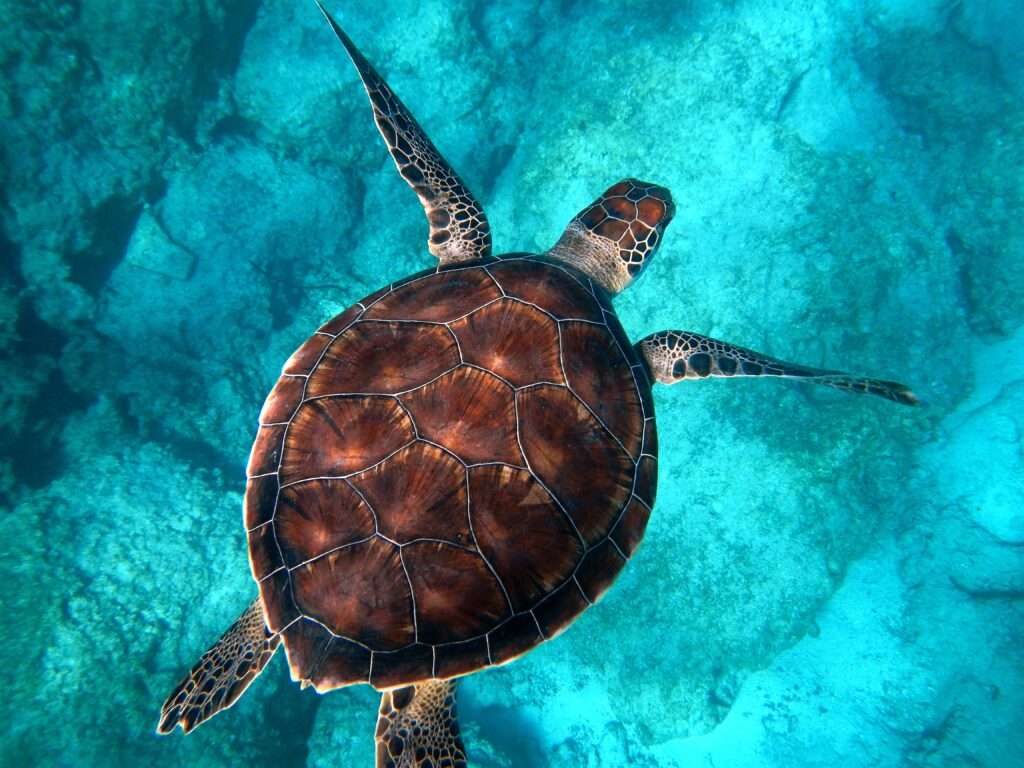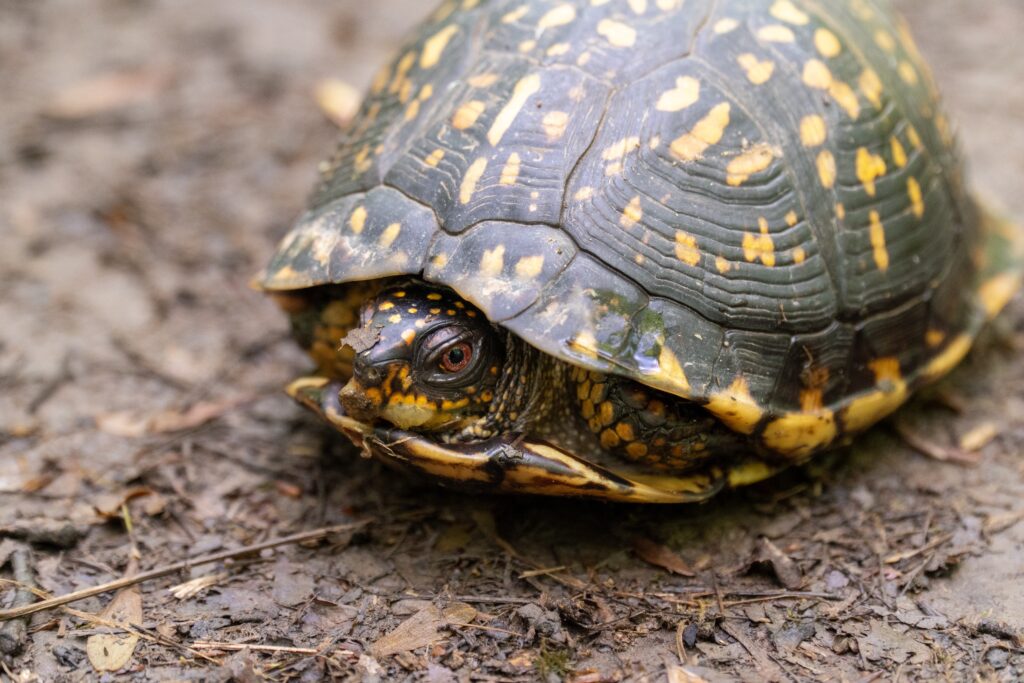Founded in 2000 by the American Turtle Rescue, World Turtle Day celebrates turtles worldwide. This holiday takes place yearly on May 23rd. Like many other creatures, turtles are facing increased pressure from habitat loss and climate change. There are around 356 known turtle species and 161 of those are listed as threatened with extinction. This includes the majority of sea turtle species. Turtles are an important part of many food chains and their declining numbers have a profound impact on their habitats and other species. Read on to discover more about turtles and take some time to celebrate them!

What Exactly are Turtles?
Diet, habitat & lifespan
Turtles are cold blooded reptiles belonging to the order Testudine. Inhabiting many different environments, from the dry desert and freshwater ponds to the vast ocean, turtles have been around since the time of the dinosaurs! One characteristic that has helped turtles survive for so long is their shell. A turtle’s shell is actually a part of its skeleton. Made up of bone and cartilage, these shells provide protection to the turtles. Their shells grow with them throughout their lives.
Although many turtles live in or near water, all turtles breathe air and lay their eggs on land. Some turtles are carnivores, some are herbivores, and others are omnivores, meaning they eat a combination of meat and plants! One interesting fact about turtles is that they have incredibly long lifespans. The oldest turtle ever recorded was Jonathan. He was a Seychelles giant tortoise who lived to be 190 years old! Even the fairly common Eastern box turtle lives for decades on average; some have been known to live for over 100 years!
Turtles Throughout Human History
Turtles have featured prominently in mythology and storytelling traditions throughout history. They appear in prehistoric rock and cave art around the world. The idea of the World Turtle, or a turtle on whose back the earth rests appears throughout many different cultures. In Hinduism, it is held that the earth rests on the back of four elephants who themselves stand on the back of a giant turtle. This turtle, called Kachhapa, is a reincarnation of the god Vishnu. Many North American Indigenous groups, including the Haudenosaunee, Annishnaabe, and Lenape peoples, also tell creation stories wherein the earth is held on the back of a turtle.
Fables, including Aesop’s The Turtle and the Hare, also show the importance of turtles in storytelling. This type of fable often personifies the turtle as wise, steadfast, and patient. Throughout the world, turtles are an important part of stories and tradition.
Why are Turtles Important?
There are many reasons to protect turtle species. These creatures are integral parts of the many ecosystems in which they exist. Since turtles eat a variety of foods, they help to protect ecosystems and maintain balance. They may act as seed dispersal systems, eating vegetative matter and spreading the seeds through their feces. Species such as the gopher tortoise dig burrows that also house other species. Freshwater turtles can help maintain the balance of their habitats. Sea turtles are integral to the maintenance of sea-grass meadows and coral reefs. Reduction or extinction of turtle populations would have far reaching effects on the many ecosystems that depend on them.

What Problems are Threatening Turtles?
After thriving on Earth for about 260 million years, turtles are in big trouble. Many different sources list them as the most vulnerable group of vertebrates. Like the majority of other threatened species, turtles are facing pressure from climate change and increased habitat loss due to human activity. Every year, hundreds of turtles die when they are struck by cars.
Light and plastic pollution are both hazardous to turtle populations. Light pollution can confuse baby sea turtles trying to make their way to the ocean after hatching. Turtles may also frequently confuse plastic debris for food and eat them. According to the World Wildlife Foundation, 52% of sea turtles have consumed plastic. Even some freshwater turtles are at risk of consuming plastic. Turtles also run the risk of becoming entangled in plastic debris. Another threat to turtles is the fishing industry. Hundreds of thousands of turtles are caught every year as a byproduct of unsustainable fishing practices.
Hunting of turtles for food, their shells, and the pet trade is also a concern for turtle populations. The demand for turtles as pets sees many turtle species removed from the wild and sold into captivity. This is especially alarming since turtles can often take over a decade to grow to sexual maturity and because turtle poachers frequently target females.
How Can I Help Turtles?
1. Reduce plastic waste
Since turtles can mistake plastic for food, it is important to keep plastic out of their environments. The best step you can take to reduce your plastic footprint is to not support the fishing industry. Fishing gear, discarded nets, and lines make the number one source of marine plastic waste, beyond any other single-use plastic. If you’re already vegan, small changes like using a reusable tote bag when shopping, bringing your own glass and straw to get coffee, and saying no to plastic utensils can have a big impact! Additionally, attending cleanups to remove litter and plastic debris can keep it from ensnaring or being eaten by a hungry turtle. For more information about reducing plastic use check out this great article by Rebecca Willems.
2. Keep light pollution away from turtle nesting sites and keep the beach obstacle free.
Although male sea turtles spend their whole adult lives in the water, females come ashore to lay their eggs. Amazingly, they return to the exact beach they were born to lay their eggs. When these eggs hatch, the young sea turtles drag themselves to the ocean to begin the cycle again. Unfortunately, brightly lit beaches are bad for both mother turtles and the young hatchlings. Female sea turtles attempting to lay eggs may be deterred from coming to shore by the bright lights. Hatchlings may become confused and unable to tell which way the ocean is.
Debris littering the beach may also make it more difficult for baby sea turtles to access the ocean. Since they are much smaller than full grown turtles, they have a harder time navigating large barriers. The longer they spend trying to reach the ocean, the more vulnerable they are to predators. Beach clean ups can help remove litter and man-made debris. Additionally, if you are spending a day at the beach, be sure to knock down sand castles and fill in holes before you leave.
3. Help turtles to cross the road
Give turtles a break! As naturally slow moving creatures, they are no match for cars. If you see a tortoise attempting to cross a road, pull over and help it! Be sure to move it in the same direction it was going. Turtles are stubborn and if you put it back on the side it came from, it will probably just try to cross again. Be careful when helping turtles cross the road and be sure to use hand sanitizer or wash your hands afterwards as turtles can carry salmonella.
If you see a turtle that has been injured by a car, you may be able to help it! Many wildlife centers will rehabilitate turtles with broken shells. Contact your local wildlife center to find out more.
4. Never buy real tortoiseshell.
Tortoiseshell is used to make jewelry, decorative trinkets, eyeglass frames, and more. Created from the shells of some turtle species, tortoiseshell cannot be created without killing the turtle. A turtle’s shell is a part of its body it cannot survive without. Sadly, demand for tortoiseshell is leading to the poaching and endangerment of some turtle species.
5. Avoid disturbing turtle burrows and habitat as much as possible.
Since turtles are experiencing rapid habitat loss, conservation is key! Leaving habitat for turtles allows them space to thrive. Additionally, other species may also utilize turtle burrows so leaving them undisturbed may help many species!
6. Raise awareness and support conservation efforts.
Turtles are valuable species in a multitude of environments. Raising awareness of their importance and their plight can help to protect them. This World Turtle Day, tell other people how cool these reptiles are! Support habitat preservation and other conservation efforts in your area.
Also by Willow Lynn: A Short History Of Cli-Fi—And My Favorite Books To Get You Started
Get more like this—Sign up for our daily inspirational newsletter for exclusive content!
__
Photo: Randall Ruiz via Unsplash; Alex He via Unsplash




